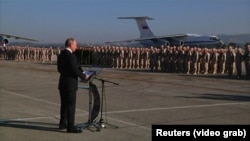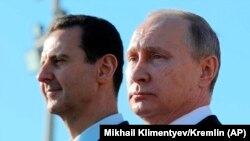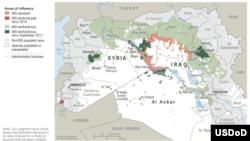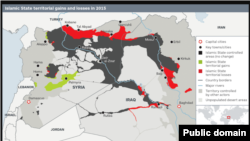On Monday, December 11, Vladimir Putin flew from Moscow to a Russian military base in Khmeimim, Syria, where he ordered withdrawal of Russian troops from Syria. The Russian president again declared victory over ISIS and said in a statement to the servicemembers, "I order the defense minister and the head of the General Staff to begin the withdrawal of the Russian group of forces to their permanent places of deployment.”
Radio Free Europe reported that Putin met at the Khmeimim base with Syrian President Bashar al-Assad, here Russia’s president said that together the Russian and Syrian forces had "crushed the most combat-capable international terrorist group."
"In light of this, I have made a decision: a significant portion of the Russian military contingent in [Syria] is returning home, to Russia," Putin said.
On December 6, Russia’s government-backed news agency, Interfax, reported that Vladimir Putin announced in a statement the liberation of Syria of all Islamic State (IS) terrorists declaring the country “completely free” of the terrorist grip of IS.
Interfax’s report was widely re-tweeted and quoted in the Russian media space. Most mentions came from government-owned media TV channel like Vesti, Zvezda, Channel One, and others.
RT repeatedly broadcasted Putin’s announcement mentioning it first in a report of the U.S. Secretary of State Tillerson’s statement about the importance of Syrian leader Bashar Assad’s direct involvement in peace talks. Putin was quoted in the last paragraph of RT’s story and said the emphasis in Syria now should be on drafting a new constitution and future elections.
On Thursday, December 7, Sergei Rudskoi, the head of the Russian General Staff, officially confirmed Putin’s statement in a press briefing on Thursday, December 7.
Max Abrahms, an assistant professor of political science and public policy at Northeastern University and advisor to national organizations on terrorism, counterterrorism strategy and militant groups, told Polygraph.info in a phone interview that there are “some” Islamic State fighters still left in Syria, adding however, that “ISIS (the Islamic State) has taken a real beating in Syria across different measures: territory, manpower, leadership, finances, recruitment and propaganda output.”
Unlike the Russian Defense Ministry, U.S. military leaders say, not all Islamic State fighters are banished from Syria. The Pentagon, in an official release of the new U.S. troop’s numbers in Iraq and Syria from December 6, 2017, estimated the militant group has been driven out of 97 percent of the territory it once held.
There are currently around 2,000 U.S. troops on the ground in Syria who will remain there to guarantee an “enduring defeat” to IS, a Pentagon spokesperson told AFP.
"We are going to maintain our commitment on the ground as long as we need to, to support our partners and prevent the return of terrorist groups," Pentagon spokesman Eric Pahon said.
He denied that Russia and the Syrian regime were responsible for meaningful progress against IS and attributed success to the United States-led coalition.
Earlier this month the U.S. Secretary of Defense James Mattis spoke about a shift in Pentagon’s posture in Syria to reflect the collapse of IS. By December, the major combat operation to retake Raqqa was over.
Pentagon officials say American troops will help with the restoration of basic services, allowing the safe distribution of humanitarian aid and helping to disable explosive devices left as the terror group fled its strongholds.
Despite Putin’s announcement on Monday at the Khmeimim military base, Russia is not withdrawing its troops from Syria either. Sergei Rudskoi said on December 6 that the Russian military would focus on humanitarian support of the Syrian people.
On December 5, the U.S. Secretary of State Rex Tillerson spoke at a bilateral meeting with the European Union High Representative Federica Mogherini about the EU --U.S. shared objectives for IS. He did not confirm the complete defeat of the terrorist group, however Tillerson said, it is “coming to an end.”
“Our shared objectives in terms of defeating ISIS are important, but not just defeating ISIS in Iraq and Syria, but defeating ISIS globally and I think continuing our discussion on joint efforts to combat terrorism wherever it raises its head. And we certainly see the result of ISIS’ caliphate and its long reign of terror that they have carried out in Iraq and Syria, which is now coming to an end,” said Tillerson.
IS territorial losses over 2017 have been substantial.
The Pentagon released an unclassified map, showing in the third quarter of 2017, IS lost a stronghold near Kirkuk in northeast Iraq, and in Syria - a pocket of fighters near Hamah in the west and sporadic areas of influence around Dayr az Zawr.
The U.S. and coalition had been providing information about the prospects for defeat of IS since past summer.
In early November 2017, Jane’s 360 -- a defense analysis think tank – published a report that cited a 70 percent drop in operations against IS by the coalition forces.
On November 7, Brigadier General Andrew Croft, the deputy air commander of the coalition’s land component, said “That’s indicative of the fact that ISIS [the Islamic State] is collapsing, not only as a physical caliphate, but also in ownership of land.”
“They only now control about 4 or 5 percent of the original area they covered. So the number of targets has dropped dramatically, particularly in the last month,” he added.
Abrahms agrees: “There is no measure in which ISIS is doing well in Syria. It is doing poorly compared to how it was doing 6 months ago and one year ago. ISIS is weakened.”
The Islamic State, which had emerged from what remained of Al Qaida in Iraq more than a decade ago had “faded into obscurity for several years,” said the Wilson Center in a 2016 report.
The militant group reemerged in 2011 amid the chaos and instability of the Syrian Civil War, overrunning parts of Iraq in 2014.
While the number of foreign fighters who joined IS from Europe, Russia, the U.S. and Saudi Arabia has shrunk, the Pentagon spokesperson, Pahon stated on December 7 that there are still more than 3,000 IS fighters between Syria and Iraq and much work has to be done to prevent the resurgence of IS.
In 2014, ISIS controlled more than 34,000 square miles in Syria and Iraq, from the Mediterranean coast to south of Baghdad. At the end of 2016, ISIS territory had shrunk to about 23,320 square miles.
IS' so-called "caliphate" shrunk 16 percent in the first nine months of 2016 and 14 percent in 2015.
In 2015, following Assad’s formal request for assistance, Russian military forces joined the fight against IS. The officially confirmed by the Russian government main part of Russia’s military campaign in Syria ran for almost six months, from September 30, 2015 to March 14, 2016.
Russia and the U.S. reached an agreement on coordinating efforts in the fight against IS in September 2016 after 10 months of failed attempts to halt the fighting.
After 5 weeks of negotiations, the two countries agreed to create a Joint Implementation Center, where they shared targeting data and coordinated bombing of militants of the Nusra Front and the Islamic State.
Both the U.S. and Russia have indicated the need for a post-war political process in Syria. In late October, the U.S. Secretary of State Rex Tillerson met with the United Nations Special Envoy for Syria Staffan de Mistura discuss a future political process in Syria. In early November, Vladimir Putin called for stabilization and laid out the conditions for a political process in Syria.










